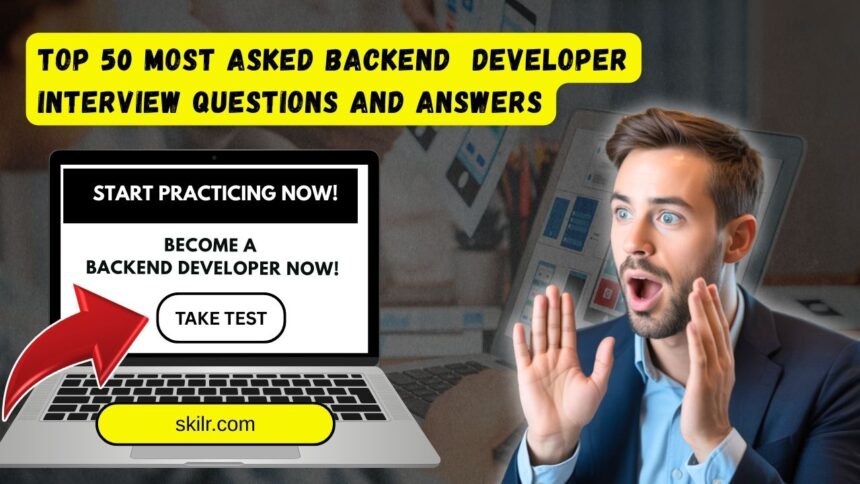Backend development forms the backbone of modern web and mobile applications. While frontend technologies shape the visual experience, backend systems ensure functionality, security, scalability, and data management. From designing efficient APIs and managing databases to handling user authentication and optimizing server performance, backend developers play a critical role in delivering reliable digital products.
For job seekers, interviews in backend development often test knowledge of programming languages, database systems, API design, scalability strategies, and security best practices. This blog compiles the top 50 backend developer interview questions and answers, designed to help you revise fundamental concepts, explore advanced topics, and confidently prepare for technical discussions.
Target Audience
This blog is intended for a wide range of readers preparing for backend development roles or seeking to strengthen their technical expertise:
- Aspiring Backend Developers – Individuals beginning their careers and looking to understand core backend principles and interview expectations.
- Experienced Developers Preparing for Interviews – Professionals aiming to refresh their knowledge and stay up to date with backend technologies and best practices.
- Full-Stack Developers Enhancing Backend Skills – Developers who work across the stack but want to improve their server-side proficiency.
- Students and Bootcamp Graduates – Learners seeking structured preparation for backend-related job opportunities.
- Software Engineers Transitioning into Backend Roles – Engineers from other domains looking to expand into backend-focused positions.
By reviewing the questions and answers in this guide, readers will gain clarity on backend fundamentals, database management, API development, scalability, and security — all of which are essential for excelling in backend developer interviews.
Core Backend Fundamentals (Questions 1–10)
- You have deployed a REST API for a product search feature. Users report that response times have jumped from 200ms to 2 seconds. Logs show no major errors, but CPU usage on the server is high. How would you troubleshoot and fix it?
Answer: First and foremost, check recent changes — Identify if any code or database query updates happened before the slowdown. Then, profile the API endpoint — Use tools likeflask-profiler,express-profiler, or APMs (e.g., New Relic, Datadog) to locate bottlenecks. Next, Inspect database queries — Check for missing indexes, long-running joins, or N+1 query problems, Further, Monitor resource usage — See if high CPU comes from inefficient loops, unoptimized JSON serialization, or external API calls. Now, Implement caching — Cache frequent search results using Redis or in-memory cache. In the end, Stress test after fix — UseJMeterork6to confirm response times return to normal. - What is the difference between frontend and backend development?
Answer: Frontend development focuses on the user interface and experience, while backend development handles the server-side logic, database management, and application functionality that supports the frontend. - What is an API?
Answer: An API (Application Programming Interface) is a set of rules and endpoints that allow different software systems to communicate. In backend development, APIs enable the frontend and backend to exchange data seamlessly. - What is REST in backend development?
Answer: REST (Representational State Transfer) is an architectural style for designing networked applications. It uses standard HTTP methods (GET, POST, PUT, DELETE) for communication and emphasizes statelessness and resource-based URLs. - What is the difference between REST and GraphQL?
Answer: REST uses predefined endpoints for each resource, whereas GraphQL allows clients to request specific data in a single query, reducing over-fetching or under-fetching of data. - What is middleware in backend frameworks?
Answer: Middleware is software that sits between the client request and server response, processing requests before they reach the main application logic. It is often used for authentication, logging, and request parsing. - What are HTTP methods commonly used in backend APIs?
Answer: Common HTTP methods include GET (retrieve data), POST (create data), PUT (update data), PATCH (partially update data), and DELETE (remove data). - What is session management in backend systems?
Answer: Session management tracks user interactions across multiple requests, often using cookies, tokens, or server-side storage to maintain user state and authentication. - What is the difference between synchronous and asynchronous processing?
Answer: Synchronous processing executes tasks one after another, blocking execution until each task finishes, while asynchronous processing allows multiple tasks to run concurrently, improving performance. - What is load balancing?
Answer: Load balancing distributes incoming network traffic across multiple servers to ensure no single server becomes overloaded, improving application availability and performance.
Databases & Data Management (Questions 11–20)
- What is the difference between SQL and NoSQL databases?
Answer: SQL databases are relational and store data in structured tables with predefined schemas, using SQL for queries. NoSQL databases are non-relational, offering flexible schemas and storing data in formats like documents, key-value pairs, or graphs. - What is database normalization?
Answer: Database normalization is the process of organizing data to reduce redundancy and improve data integrity. It involves structuring tables and relationships according to normal forms. - What are database indexes and why are they used?
Answer: Indexes are data structures that improve query performance by enabling faster data retrieval. They work like a book index, allowing quick location of information without scanning the entire dataset. - What are ACID properties in databases?
Answer: ACID stands for Atomicity, Consistency, Isolation, and Durability — key principles ensuring reliable transaction processing in relational databases. - What is the difference between primary key and foreign key?
Answer: A primary key uniquely identifies each record in a table, while a foreign key is a field in one table that links to the primary key in another table, establishing relationships. - What is database sharding?
Answer: Database sharding is the practice of splitting a large database into smaller, faster, and more manageable pieces called shards, each stored on different servers. - What is a transaction in a database?
Answer: A transaction is a sequence of database operations executed as a single unit. Transactions follow ACID properties to ensure data integrity. - What is a stored procedure?
Answer: A stored procedure is a precompiled set of SQL statements stored in the database, which can be executed to perform specific tasks like inserting, updating, or deleting data. - What is database replication?
Answer: Database replication involves copying data from one database server to another to improve availability, fault tolerance, and load distribution. - What is query optimization?
Answer: Query optimization is the process of improving the performance of database queries by analyzing execution plans, using indexes, and restructuring queries for efficiency.
APIs, Frameworks & Backend Technologies (Questions 21–30)
- What is API versioning and why is it important?
Answer: API versioning is the practice of managing changes to an API by assigning version numbers. It ensures backward compatibility for existing clients while allowing improvements and new features. - What is the difference between monolithic and microservices architecture?
Answer: In a monolithic architecture, all components of an application are integrated into a single codebase, making deployment simpler but less scalable. Microservices architecture breaks the application into independent services, improving scalability and maintainability but adding complexity. - What is a message queue in backend development?
Answer: A message queue is a communication system that stores and manages messages between services or applications, enabling asynchronous processing and decoupling components. Examples include RabbitMQ and Apache Kafka. - What is caching and why is it used?
Answer: Caching stores frequently accessed data in a temporary storage layer for faster retrieval. It reduces database load, improves response time, and enhances application performance. - What are some common backend frameworks?
Answer: Popular backend frameworks include Express.js (Node.js), Django (Python), Flask (Python), Spring Boot (Java), and Laravel (PHP). They provide tools and structures for building robust server-side applications. - What is GraphQL and how does it differ from REST?
Answer: GraphQL is a query language for APIs that allows clients to request specific data in a single query. Unlike REST, which uses multiple endpoints, GraphQL uses a single endpoint and can reduce over-fetching and under-fetching of data. - What is ORM (Object-Relational Mapping)?
Answer: ORM is a technique that allows developers to interact with a database using the programming language’s objects instead of writing raw SQL queries. Examples include Hibernate, Sequelize, and SQLAlchemy. - What is the difference between SOAP and REST APIs?
Answer: SOAP is a protocol with strict messaging standards, typically using XML, while REST is an architectural style that uses standard HTTP methods and supports multiple formats like JSON and XML. - What is the role of an API gateway in microservices?
Answer: An API gateway acts as a single entry point for client requests in a microservices architecture, handling routing, authentication, rate limiting, and load balancing. - What is serverless architecture?
Answer: Serverless architecture allows developers to build and deploy applications without managing servers. Cloud providers automatically handle scaling, provisioning, and infrastructure management. Examples include AWS Lambda and Azure Functions.
Scalability, Performance & Security (Questions 31–40)
- What is horizontal scaling?
Answer: Horizontal scaling involves adding more servers or instances to handle increased load, distributing traffic evenly to maintain performance and availability. - What is vertical scaling?
Answer: Vertical scaling increases a single server’s resources (CPU, RAM, storage) to handle more workload. It is simpler to implement but limited by hardware capacity. - What is CDN and how does it improve performance?
Answer: A Content Delivery Network (CDN) is a distributed network of servers that delivers web content from locations closer to the user, reducing latency and improving load times. - What is rate limiting in backend systems?
Answer: Rate limiting controls the number of requests a user or system can make in a given time frame, preventing abuse and protecting system stability. - What is the difference between authentication and authorization?
Answer: Authentication verifies a user’s identity, while authorization determines what resources the authenticated user is allowed to access. - What is HTTPS and why is it important?
Answer: HTTPS (Hypertext Transfer Protocol Secure) encrypts communication between client and server using SSL/TLS, ensuring data privacy and security. - What is SQL injection?
Answer: SQL injection is a security vulnerability where attackers insert malicious SQL statements into input fields, allowing unauthorized access or manipulation of the database. - What is Cross-Site Scripting (XSS)?
Answer: XSS is a security flaw where attackers inject malicious scripts into web pages, which are then executed in the browser of other users, potentially stealing data or compromising security. - What is load testing and why is it important?
Answer: Load testing evaluates how a system performs under expected traffic conditions, helping identify bottlenecks and optimize performance before deployment. - What is penetration testing?
Answer: Penetration testing simulates cyberattacks on a system to identify vulnerabilities, assess security measures, and recommend improvements.
Advanced Concepts & Best Practices (Questions 41–50)
- What is containerization in backend development?
Answer: Containerization is the practice of packaging applications and their dependencies into lightweight, portable containers that run consistently across environments. Docker is a popular containerization platform. - What is the difference between Docker and Kubernetes?
Answer: Docker is a platform for creating and running containers, while Kubernetes is an orchestration system that manages container deployment, scaling, and networking across clusters. - What is CI/CD in backend development?
Answer: CI/CD (Continuous Integration and Continuous Deployment) is a set of practices that automate code integration, testing, and deployment, ensuring faster and more reliable software delivery. - What is a reverse proxy?
Answer: A reverse proxy sits between clients and backend servers, forwarding client requests to the appropriate server. It improves security, load balancing, and caching. - What is the difference between synchronous APIs and asynchronous APIs?
Answer: Synchronous APIs wait for a request to complete before responding, while asynchronous APIs allow the server to process requests in the background and send responses later. - What is event-driven architecture?
Answer: Event-driven architecture is a design pattern where services communicate by producing and consuming events, enabling loosely coupled and highly scalable systems. - What is monitoring in backend systems?
Answer: Monitoring involves tracking system performance, errors, and usage metrics to ensure uptime, detect issues, and maintain service quality. Tools like Prometheus, Grafana, and New Relic are commonly used. - What is API throttling?
Answer: API throttling controls the usage of an API by limiting the number of requests a client can make within a given period, preventing overuse and ensuring fair resource allocation. - What is the difference between stateless and stateful applications?
Answer: Stateless applications do not store client data between requests, making them easier to scale, while stateful applications maintain client data across sessions. - What are some backend best practices for production systems?
Answer: Best practices include using secure authentication, optimizing database queries, implementing caching, enabling logging and monitoring, automating deployments, and conducting regular security audits.
Conclusion
Preparing for a backend developer interview requires a strong understanding of databases, API design, server architecture, scalability, and security best practices. The questions and answers in this guide cover both foundational knowledge and advanced concepts, ensuring you are well-prepared for technical discussions. By revising these topics, practicing problem-solving, and understanding real-world applications, you can approach interviews with confidence and demonstrate your ability to build efficient, secure, and scalable backend systems.





